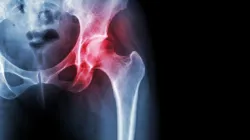Hip arthritis tends to manifest in various forms, each with different characteristics and underlying causes. Hip arthritis means the deterioration of the cartilage of the hip joint. It can create challenges for one who is grappling with this form of arthritis. Here are different types of hip arthritis that one should be aware of. One should seek timely intervention to improve the quality of life.
Osteoarthritis of the hip: This is the most common form of arthritis, and the hip is the second most frequently impacted joint, according to Dr Aashish Arbat, Orthopedic & Joint Replacement Surgeon, Jehangir Multispeciality Hospitals, Pune. Osteoarthritis will cause wear and tear of the cartilage, as a result, it becomes thinner and the surfaces of the joint tend to get rougher. The symptoms of this type of arthritis are swelling, pain, and stiffness, but not everyone will have these symptoms. The causes of this arthritis are family history, obesity, hip injury, hip joint problems, age, and repetitive activities leading to hip pain. The treatment of it is exercise, weight loss, physical therapy, medication, and rest. Surgical treatment includes a total hip replacement (arthroplasty) wherein the damaged hip socket and the head of the femur are removed and replaced with implants made with the help of metal, plastic, ceramic, or some combination. This minimally invasive surgery offers relief from hip pain, is safe, and aids in the swift recovery of the patient.
Rheumatoid arthritis (RA): It is an autoimmune disorder where the body's immune system mistakenly attacks healthy joint tissues. This condition often strikes earlier in life compared to osteoarthritis and tends to affect both sides of the body symmetrically. Patients might experience fatigue alongside hip pain that can be unbearable. When RA impacts one's hip, he/she will have difficulty in walking, jogging, climbing stairs, playing sports, sitting or standing. Other symptoms are pain in the groin area. The causes are smoking, obesity, and age. Medication and low-impact exercises are generally advised to the patient. However, extreme hip pain will need a hip replacement to improve mobility and restore the range of motion. The success rate of a hip replacement is more than 95% and offers the best results to the patients.
AVN: Osteonecrosis or avascular necrosis (AVN) or aseptic necrosis can occur in any bone, though osteonecrosis most commonly takes a toll on one’s hip or even both hips. The symptoms are intermittent pain in the affected joint, persistent aches that disrupt daily activities, and limited mobility. Osteonecrosis of the hip happens when blood flow to the femoral head is disrupted, leading to bone death and potentially debilitating joint pain. Lifestyle choices like smoking and obesity contribute to inflammation and raise the chances of arthritis. Hip replacement is done to remove the damaged bone and cartilage, and place a new metal or plastic joint surface to restore one’s hip function.
It is imperative to understand the difference between these various forms of arthritis and seek timely treatment as per the doctor’s advice. Hip replacement is a promising solution for those struggling with any type of hip arthritis.
ALSO READ: Swelled nerves? It can be cause of varicose veins, know symptoms and treatment

